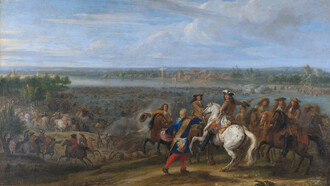Not all mental images are suitable to be stored easily; I say “stored easily” and not simply “memorized”, since all mental images can be memorized, even if some of them with difficulty. As we have seen in a previous article the first characteristic of the mnemonic images is that they must be well defined. And we should not confuse the concept of the definition of the images with that of the resolution of the photographs. The one is not the other's metaphor. Our imagination is not a camera. Mnemonic images must have certain characteristics, the main of which we will examine in this article: emotion, exaggeration, eccentricity, movement; they should also be parameterisable and configurable.
Emotive images
Every image that we represent to ourselves for mnemonic purposes must always be accompanied by an emotion, it should always arouse a feeling. The association between image and sentiment improves the memory of the linked idea: in this way the idea is not anchored to one but to two different elements (picture and feeling). This ensures a better attachment to the memory. We must always be involved emotionally by what we think so that the memories hold better. No image that we think should be indifferent: everything must attract or disgust, affect or repulse. Everything should have an emotional tone; but given that in reality there are so many things that remain indifferent, we must make an effort to associate an emotion to every idea or thought which we want to store.
The emotion that evokes a memory of a real event is easy to identify because it is tied to our life experience. A fact we only imagined, so that it can be remembered, must be covered in advance by an emotion. Whereas natural memory generates an emotion; in the case of mnemonics it must be the emotion that helps to arouse the memory. We have to work on ourselves in a manner similar to how John B. Watson did with the little Albert: a kind of self-inflicted operant conditioning entirely within the imagination. The example of Watson’s experiment is deliberately exaggerated, it serves for me to highlight one principle: if we condition ourselves to thinking scary or beautiful things, we can then memorize them better. Thus, in this case, rote repetition is a correct activity to follow since there is no conditioning without repetition of the stimulus; except that this kind of repetition is not completely rote. In fact, we must add an emotion to it, always the same, in order to strengthen and anchor the image to the feeling and then to the memory.
John Broadus Watson (January 9, 1878 – September 25, 1958) was an American psychologist, a leading exponent of the psychological school of behaviorism. In a famous and rightfully criticized experiment, he frightened a little child (Albert) with a loud noise when he was playing with a white rat. The experiment repeated several times influenced the child. At first, Albert screamed when he heard the noise, but then he also screamed at the sight of the white mouse. Watson and his wife Rosalie observed that the induced fear was followed by a process of generalization: after conditioning, Albert was frightened also in the presence of other animals with white fur, as well as of woolly and white objects. [1]
Inside the mnemonic use, emotions are only self-induced suggestions. In general, we can say that no thought is emotionally neutral, but there are a lot of ideas and/or thoughts that are accompanied by emotions too weak to help memory. We must intensify these weak feelings. One of the best ways to do this is to exaggerate the mental images through the fantasy.
Exaggeration of images
Strong and excessive images stay in our mind longer than normal and weak ones. This occurs in part because exaggerations attract our attention more, but otherwise we have to say that our mind is not attracted by what is similar and ordinary. If we pass every day in front of a shop window and on show there are always the same goods – when we think about it – we cannot distinguish in our memory one day from the other. The same thing happens when on show there are different products, but they are of the same typology (and/or dimension and/or shape) of those previously shown. However, if one day there is something really different which exceeds by type, size or shape, it affects both our attention and our memory: attention at the moment and memory as time goes on. We must pay attention to our memories. It is not a pun. To be retrieved our memories must have something special, something that makes them different and distinguishable from the many trivial things that seem superfluous to recall. Thunder draws our attention in proportion to its noise and how near the lightning is; while walking on the street, if we meet a tall man, 2.10m, he will probably remain in our memory more than one of 1.75m.
An outlandish person attracts attention and captures imagination more than other people. Seeing a man who bites dog is engrave in the memory since it is unusual. Eccentric images are a variant of those exaggerated: usually exaggeration is only quantitatively different from normality, furthermore, in most cases, they refer to a single image. To the contrary, the eccentric images are composite representations in which one or more elements are combined in an unusual, unpredictable and even unlikely way. An ordinary event is a fact that recurs frequently in the same – or almost the same – way. The exceptional fact forces us to create new categories or, at least, to find out which category of existing ones to add to it.
The “exceptional” involves an effort, namely mental activities that try to bring it back to the ordinary or – at least – that bring it back to categories and classification methods that render it less abnormal and more easily identifiable in the future. Moreover, extravagant and eccentric images compel our minds to create new connections between new and old concepts, ideas and representations; they force us to formulate new judgments. This is a good exercise for our memory. So the rule is: to memorize fast and easily we have to think of normal things in an exaggerated and extravagant way. This is what all the mnemonics handbooks ultimately say. In my opinion, this is the truth up to a point. It depends on how much a person is trained to imagine. The more readily you can imagine, the less you need to think strange things. Indeed, you have to put your mind in a mnemonic state. You have to think about your mental images as if they were to remain forever in your mind. In this way even an insipid, bland image, can take on a mnemonic value without any peculiar characteristic, but only for an exercise of the will to imagine and memorize.
Moving pictures
In the classic art of memory moving images were defined “imagines agentes”, or images in which there is someone or something that performs an action on someone or something else. The concept of “imagines agentes” is rather complex, as we will analyze later. For now let's just say that a moving object attracts our attention and persists in our memory better than a static one. This happens for several reasons. The main one is that an immovable object is considered singly and individually, sub specie aeternitatis; on the contrary, a moving image is always considered in relation to something else. The imagined (or real) object comes close to something or draws away from something else. The concept of movement always refers to that of relation: the relationship between places and/or objects, the relation between concepts and/or mental images and so on. So, in mnemonic places, with more than a single element, we should always imagine skits, one or more little scenes in which there is something moving and acting.
Parameterizing
Parameterizing mnemonic objects (i.e. the concepts to be stored) in our mind means enlarging or shrinking to adapt their images to the places where we put them, or adjusting the images with the images of other objects that we have to memorize. It is a continuous arrangement that we must make between images and between images and places, a zoom action that invests not only merely the size of an image but also the prospective on it. This is an excellent way to keep the same proportions between objects (and, metaphorically, concepts) even in our imagination. If I have to imagine a bottle of milk at one meter and another at twice the distance, surely I shall imagine the first bigger than the latter. Practising consciously the exercise to parameterize mental images, changing the size that naturally we would be inclined to attribute to them, is a fundamental exercise of the art of memory, often not sufficiently appreciated by many scholars of this discipline.
All in one
All characteristics analyzed so far and others (especially synaesthesia) described in a previous article, [2] should be present simultaneously in each image created for mnemonic purposes. All these elements make mental images easy to remember, in some cases even unforgettable. Of course, we should not deal too much with combining all these aspects of mental images; with time and with regular exercise this operation should become natural.
Notes:
[1] John B. Watson and Rosalie Rayner, Conditioned emotional reactions, Journal of Experimental Psychology, 1920, 3(1), 1-14.
[2] P. Fabiani, Memory and the “dual coding” theory - How mental associations and imagination can help your study














